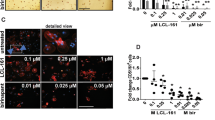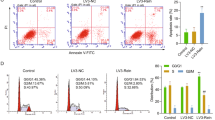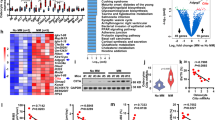Abstract
Osteolytic bone disease in multiple myeloma (MM) is caused by enhanced osteoclast (OCL) activation and inhibition of osteoblast function. Lenalidomide and bortezomib have shown promising response rates in relapsed and newly diagnosed MM, and bortezomib has recently been reported to inhibit OCLs. We here investigated the effect of lenalidomide on OCL formation and osteoclastogenesis in comparison with bortezomib. Both drugs decreased αVβ3-integrin, tartrate-resistant acid phosphatase-positive cells and bone resorption on dentin disks. In addition, both agents decreased receptor activator of nuclear factor-κB ligand (RANKL) secretion of bone marrow stromal cells (BMSCs) derived from MM patients. We identified PU.1 and pERK as major targets of lenalidomide, and nuclear factor of activated T cells of bortezomib, resulting in inhibition of osteoclastogenesis. Furthermore, downregulation of cathepsin K, essential for resorption of the bone collagen matrix, was observed. We demonstrated a significant decrease of growth and survival factors including macrophage inflammatory protein-α, B-cell activating factor and a proliferation-inducing ligand. Importantly, in serum from MM patients treated with lenalidomide, the essential bone-remodeling factor RANKL, as well as the RANKL/OPG ratio, were significantly reduced, whereas osteoprotegerin (OPG) was increased. We conclude that both agents specifically target key factors in osteoclastogenesis, and could directly affect the MM-OCL-BMSCs activation loop in osteolytic bone disease.
This is a preview of subscription content, access via your institution
Access options
Subscribe to this journal
Receive 12 print issues and online access
$259.00 per year
only $21.58 per issue
Buy this article
- Purchase on Springer Link
- Instant access to full article PDF
Prices may be subject to local taxes which are calculated during checkout





Similar content being viewed by others
References
Hideshima T, Anderson KC . Molecular mechanisms of novel therapeutic approaches for multiple myeloma. Nat Rev Cancer 2002; 2: 927–937.
Richardson PG, Blood E, Mitsiades CS, Jagannath S, Zeldenrust SR, Alsina M et al. A randomized phase 2 study of lenalidomide therapy for patients with relapsed or relapsed and refractory multiple myeloma. Blood 2006; 108: 3458–3464.
Dimopoulos M, Spencer A, Attal M, Prince HM, Harousseau JL, Dmoszynska A et al. Lenalidomide plus dexamethasone for relapsed or refractory multiple myeloma. N Engl J Med 2007; 357: 2123–2132.
Weber DM, Chen C, Niesvizky R, Wang M, Belch A, Stadtmauer EA et al. Lenalidomide plus dexamethasone for relapsed multiple myeloma in North America. N Engl J Med 2007; 357: 2133–2142.
Jagannath S, Barlogie B, Berenson J, Siegel D, Irwin D, Richardson PG et al. A phase 2 study of two doses of bortezomib in relapsed or refractory myeloma. Br J Haematol 2004; 127: 165–172.
Richardson PG, Sonneveld P, Schuster MW, Irwin D, Stadtmauer EA, Facon T et al. Bortezomib or high-dose dexamethasone for relapsed multiple myeloma. N Engl J Med 2005; 352: 2487–2498.
Callander NS, Roodman GD . Myeloma bone disease. Semin Hematol 2001; 38: 276–285.
Berenson JR, Lichtenstein A, Porter L, Dimopoulos MA, Bordoni R, George S et al., Myeloma Aredia Study Group. Efficacy of pamidronate in reducing skeletal events in patients with advanced multiple myeloma. N Engl J Med 1996; 334: 488–493.
Lee JW, Chung HY, Ehrlich LA, Jelinek DF, Callander NS, Roodman GD et al. IL-3 expression by myeloma cells increases both osteoclast formation and growth of myeloma cells. Blood 2004; 103: 2308–2315.
Tian E, Zhan F, Walker R, Rasmussen E, Ma Y, Barlogie B et al. The role of the Wnt-signaling antagonist DKK1 in the development of osteolytic lesions in multiple myeloma. N Engl J Med 2003; 349: 2483–2494.
Zangari M, Esseltine D, Lee CK, Barlogie B, Elice F, Burns MJ et al. Response to bortezomib is associated to osteoblastic activation in patients with multiple myeloma. Br J Haematol 2005; 131: 71–73.
Terpos E, Heath DJ, Rahemtulla A, Zervas K, Chantry A, Anagnostopoulos A et al. Bortezomib reduces serum dickkopf-1 and receptor activator of nuclear factor-kappaB ligand concentrations and normalises indices of bone remodelling in patients with relapsed multiple myeloma. Br J Haematol 2006; 135: 688–692.
von Metzler I, Krebbel H, Hecht M, Manz RA, Fleissner C, Mieth M et al. Bortezomib inhibits human osteoclastogenesis. Leukemia 2007; 21: 2025–2234.
Anderson G, Gries M, Kurihara N, Honjo T, Anderson J, Donnenberg V et al. Thalidomide derivative CC-4047 inhibits osteoclast formation by down-regulation of PU.1. Blood 2006; 107: 3098–3105.
Hideshima T, Chauhan D, Podar K, Schlossman RL, Richardson P, Anderson KC . Novel therapies targeting the myeloma cell and its bone marrow microenvironment. Semin Oncol 2001; 28: 607–612.
Richardson PG, Sonneveld P, Schuster MW, Irwin D, Stadtmauer EA, Facon T et al. Bortezomib or high-dose dexamethasone for relapsed multiple myeloma. N Engl J Med 2005; 352: 2487–2498.
Grigoriadis AE, Wang ZQ, Cecchini MG, Hofstetter W, Felix R, Fleisch HA et al. c-Fos: a key regulator of osteoclast-macrophage lineage determination and bone remodeling. Science 1994; 266: 443–448.
Rieman DJ, McClung HA, Dodds RA, Hwang SM, Holmes MW, James IE et al. Biosynthesis and processing of cathepsin K in cultured human osteoclasts. Bone 2001; 28: 282–289.
Faccio R, Grano M, Colucci S, Villa A, Giannelli G, Quaranta V et al. Localization and possible role of two different alpha v beta 3 integrin conformations in resting and resorbing osteoclasts. J Cell Sci 2002; 115 (Part 14): 2919–2929.
Lee SE, Woo KM, Kim SY, Kim HM, Kwack K, Lee ZH et al. The phosphatidylinositol 3-kinase, p38, and extracellular signal-regulated kinase pathways are involved in osteoclast differentiation. Bone 2002; 30: 71–77.
Tondravi MM, McKercher SR, Anderson K, Erdmann JM, Quiroz M, Maki R et al. Osteopetrosis in mice lacking haematopoietic transcription factor PU.1. Nature 1997; 386: 81–84.
Boyle WJ, Simonet WS, Lacey DL . Osteoclast differentiation and activation. Nature 2003; 423: 337–342.
Grigoriadis AE, Wang ZQ, Cecchini MG, Hofstetter W, Felix R, Fleisch HA et al. c-Fos: a key regulator of osteoclast-macrophage lineage determination and bone remodeling. Science 1994; 266: 443–448.
Wang ZQ, Ovitt C, Grigoriadis AE, Mohle-Steinlein U, Ruther U, Wagner EF . Bone and haematopoietic defects in mice lacking c-fos. Nature 1992; 360: 741–745.
Takayanagi H, Kim S, Koga T, Nishina H, Isshiki M, Yoshida H et al. Induction and activation of the transcription factor NFATc1 (NFAT2) integrate RANKL signaling in terminal differentiation of osteoclasts. Dev Cell 2002; 3: 889–901.
Oyajobi BO, Franchin G, Williams PJ, Pulkrabek D, Gupta A, Munoz S et al. Dual effects of macrophage inflammatory protein-1alpha on osteolysis and tumor burden in the murine 5TGM1 model of myeloma bone disease. Blood 2003; 102: 311–319.
Han JH, Choi SJ, Kurihara N, Koide M, Oba Y, Roodman GD . Macrophage inflammatory protein-1alpha is an osteoclastogenic factor in myeloma that is independent of receptor activator of nuclear factor kappaB ligand. Blood 2001; 97: 3349–3353.
Choi SJ, Cruz JC, Craig F, Chung H, Devlin RD, Roodman GD et al. Macrophage inflammatory protein 1-alpha is a potential osteoclast stimulatory factor in multiple myeloma. Blood 2000; 96: 671–675.
Abe M, Hiura K, Wilde J, Moriyama K, Hashimoto T, Ozaki S et al. Role for macrophage inflammatory protein (MIP)-1alpha and MIP-1beta in the development of osteolytic lesions in multiple myeloma. Blood 2002; 100: 2195–2202.
Lentzsch S, Gries M, Janz M, Bargou R, Dorken B, Mapara MY . Macrophage inflammatory protein 1-alpha (MIP-1 alpha) triggers migration and signaling cascades mediating survival and proliferation in multiple myeloma (MM) cells. Blood 2003; 101: 3568–3573.
Moore PA, Belvedere O, Orr A, Pieri K, La Fleur DW, Feng P et al. BLyS: member of the tumor necrosis factor family and B lymphocyte stimulator. Science 1999; 285: 260–263.
Hahne M, Kataoka T, Schroter M, Hofmann K, Irmler M, Bodmer JL et al. APRIL, a new ligand of the tumor necrosis factor family, stimulates tumor cell growth. J Exp Med 1998; 188: 1185–1190.
Moreaux J, Cremer FW, Reme T, Raab M, Mahtouk K, Kaukel P et al. The level of TACI gene expression in myeloma cells is associated with a signature of microenvironment dependence versus a plasmablastic signature. Blood 2005; 106: 1021–1030.
Tai YT, Li XF, Breitkreutz I, Song W, Neri P, Catley L et al. Role of B-cell-activating factor in adhesion and growth of human multiple myeloma cells in the bone marrow microenvironment. Cancer Res 2006; 66: 6675–6682.
Moreaux J, Legouffe E, Jourdan E, Quittet P, Reme T, Lugagne C et al. BAFF and APRIL protect myeloma cells from apoptosis induced by interleukin 6 deprivation and dexamethasone. Blood 2004; 103: 3148–3157.
Moreaux J, Cremer FW, Reme T, Raab M, Mahtouk K, Kaukel P et al. The level of TACI gene expression in myeloma cells is associated with a signature of microenvironment dependence versus a plasmablastic signature. Blood 2005; 106: 1021–1030.
Abe M, Kido S, Hiasa M, Nakano A, Oda A, Amou H et al. BAFF and APRIL as osteoclast-derived survival factors for myeloma cells: a rationale for TACI-Fc treatment in patients with multiple myeloma. Leukemia 2006; 20: 1313–1315.
Yaccoby S, Pennisi A, Li X, Dillon SR, Zhan F, Barlogie B et al. Atacicept (TACI-Ig) inhibits growth of TACI(high) primary myeloma cells in SCID-hu mice and in coculture with osteoclasts. Leukemia 2008; 22: 406–413.
Sezer O, Heider U, Jakob C, Zavrski I, Eucker J, Possinger K et al. Immunocytochemistry reveals RANKL expression of myeloma cells. Blood 2002; 99: 4646–4647.
Farrugia AN, Atkins GJ, To LB, Pan B, Horvath N, Kostakis P et al. Receptor activator of nuclear factor-kappaB ligand expression by human myeloma cells mediates osteoclast formation in vitro and correlates with bone destruction in vivo. Cancer Res 2003; 63: 5438–5445.
Sezer O, Heider U, Zavrski I, Kuhne CA, Hofbauer LC . RANK ligand and osteoprotegerin in myeloma bone disease. Blood 2003; 101: 2094–2098.
Vanderkerken K, De Leenheer E, Shipman C, Asosingh K, Willems A, Van Camp B et al. Recombinant osteoprotegerin decreases tumor burden and increases survival in a murine model of multiple myeloma. Cancer Res 2003; 63: 287–289.
Terpos E, Szydlo R, Apperley JF, Hatjiharissi E, Politou M, Meletis J et al. Soluble receptor activator of nuclear factor kappaB ligand-osteoprotegerin ratio predicts survival in multiple myeloma: proposal for a novel prognostic index. Blood 2003; 102: 1064–1069.
Terpos E, Mihou D, Szydlo R, Tsimirika K, Karkantaris C, Politou M et al. The combination of intermediate doses of thalidomide with dexamethasone is an effective treatment for patients with refractory/relapsed multiple myeloma and normalizes abnormal bone remodeling, through the reduction of sRANKL/osteoprotegerin ratio. Leukemia 2005; 19: 1969–1976.
Acknowledgements
We thank the patients, nursing staff as well as the clinical research coordinators of the Jerome Lipper Multiple Myeloma Center/Dana-Farber Cancer Institute, for their help in providing serum specimens for this study. This work was supported by the Multiple Myeloma Research Foundation, LeBow Fund to Cure Myeloma (KCA); National Foundation of Cancer Research and NIH grants CA50947, CA78373 and CA10070.
Author information
Authors and Affiliations
Corresponding author
Additional information
Supplementary Information accompanies the paper on the Leukemia website (http://www.nature.com/leu)
Supplementary information
Rights and permissions
About this article
Cite this article
Breitkreutz, I., Raab, M., Vallet, S. et al. Lenalidomide inhibits osteoclastogenesis, survival factors and bone-remodeling markers in multiple myeloma. Leukemia 22, 1925–1932 (2008). https://doi.org/10.1038/leu.2008.174
Received:
Revised:
Accepted:
Published:
Issue Date:
DOI: https://doi.org/10.1038/leu.2008.174
Keywords
This article is cited by
-
The roles of osteoprotegerin in cancer, far beyond a bone player
Cell Death Discovery (2022)
-
Pathogenesis of bone disease in multiple myeloma: from bench to bedside
Blood Cancer Journal (2018)
-
The orally available multikinase inhibitor regorafenib (BAY 73-4506) in multiple myeloma
Annals of Hematology (2018)
-
Immunomodulatory Drugs in Multiple Myeloma: Mechanisms of Action and Clinical Experience
Drugs (2017)
-
An Evidence-Based Approach to Myeloma Bone Disease
Current Hematologic Malignancy Reports (2017)



